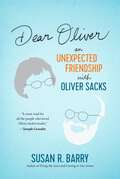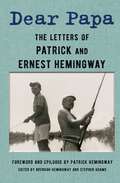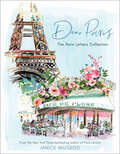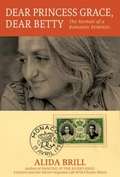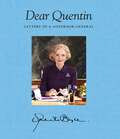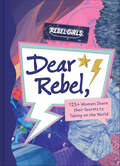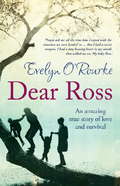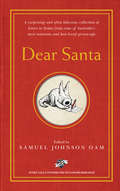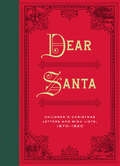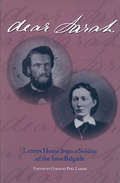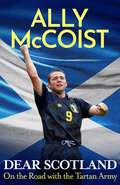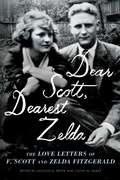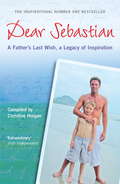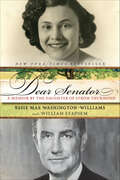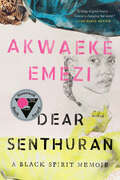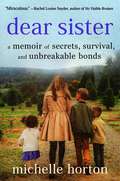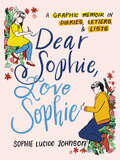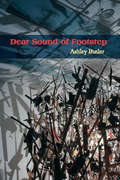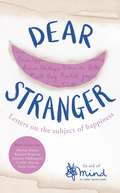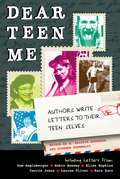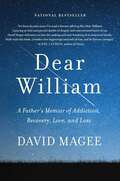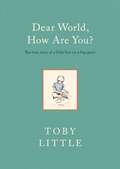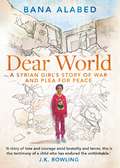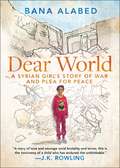- Table View
- List View
Dear Oliver: An Unexpected Friendship With Oliver Sacks
by Susan R. BarryA heartfelt memoir that captures the meeting of two great minds—and, with boundless generosity, shares the joy of what it's like to make, have, and keep a friend later in life To the world, he was Dr. Sacks, the brilliant neurologist behind bestselling books like Musicophilia and The Man Who Mistook His Wife for a Hat. To professor Susan Barry, he became Dear Oliver—her mentor, friend, and confidant over the course of their unlikely, engrossing ten-year correspondence. It begins with a letter that Sue almost doesn't send. Dear Dr. Sacks . . . You asked me if I could imagine what the world would look like when viewed with two eyes. Sue’s unheard-of case history—as a “stereoblind” patient who acquired 3D vision in adulthood—so fascinates Dr. Sacks that he immediately asks to visit her. As “Stereo Sue,” she becomes the subject of one of his indelible New Yorker pieces—and, as a fellow neuroscientist, his sounding board for every kind of intellectual inquiry. Their shared passions—from classical music to cuttlefish, brain plasticity to bioluminescent plankton—spark a friendship that buoys both of them through life’s crests and falls: as Sue becomes an author in her own right, as she supports her father in his decline, and as Oliver becomes a patient himself—battling cancer that, in a painful twist, robs him of his own vision. Dr. Sacks’s letters to Sue offer his devoted readers an unprecedented glimpse of the man himself—from his legendary compassion and insight to his love of the periodic table (which he kept in his wallet). Throughout Dear Oliver, we are reminded that true friends help each other see the world a little differently.
Dear Papa: The Letters of Patrick and Ernest Hemingway
by Ernest Hemingway Patrick HemingwayAn intimate and illuminating glimpse at Ernest Hemingway as a father, revealed through a selection of letters he and his son Patrick exchanged over the span of twenty years.In the public imagination, Ernest Hemingway looms larger than life. But the actual person behind the legend has long remained elusive. Now, his son Patrick shares the letters they exchanged over two decades, offering a glimpse into how one of America&’s most iconic writers interacted with his children. These letters reveal a father who wished for his children to share his interests—hunting, fishing, travel—and a son who was receptive to the experiences his father offered. Edited by and including an introduction by Patrick Hemingway&’s nephew Brendan Hemingway and his grandson Stephen Adams, and featuring a prologue and epilogue by Patrick reflecting on his father&’s legacy, Dear Papa is a loving and collaborative family project and a nuanced, fascinating portrait of a father and son.
Dear Paris: The Paris Letters Collection
by Janice MacLeodEat, Pray, Love meets Claude Monet in this epistolary ode to the French capital from the New York Times–bestselling author of Paris Letters.What started as a whim in a Latin Quarter café blossomed into Janice MacLeod’s years-long endeavor to document and celebrate life in Paris, sending monthly snippets of her paintings and writings to the mailboxes of ardent followers around the world. Now, Dear Paris collects the entirety of the Paris Letters project: 140 illustrated messages discussing everything from macarons to Montmartre.For readers familiar with the city, Dear Paris is a rendezvous with their own memories, like the first time they walked along the Champs-Élysées or the best pain au chocolat they’ve ever tasted. But it’s about more than just a Paris frozen in nostalgia; the book paints the city as it is today, through elections, protests, and the World Cup—and through the people who call it home. Wistful, charming, surprising, and unfailingly optimistic, Dear Paris is a vicarious visit to one of the most iconic and beloved places in the world.Praise for Paris Letters“Janice MacLeod’s charming Paris Letters takes us on her starry-eyed discovery of Paris, the joys of learning the French language, a unique career in art and, best of all, the romance of a lifetime! C’est bon!” —Lynne Martin, author of Home Sweet Anywhere“Written as though to a best friend telling her story over lattes—or café crème. Relatable and inspiring . . . cleverly crafted with wit and unexpected wisdom.” —New York Journal of Books
Dear Princess Grace, Dear Barbie, Dear Betty
by Alida BrillDEAR PRINCESS GRACE, DEAR BARBIE, DEAR BETTY is a candid and insightful memoir by the feminist writer and social critic Alida Brill (co-author of DANCING AT THE RIVER’S EDGE: A Patient and Her Doctor Negotiate Life With Chronic Illness) that spans her life from the onset of the modern women’s movement in the early 1960’s through the second wave in the 70’s and 80’s in which she became a leading figure and spokesperson. Her story begins in a post-war suburban town in Orange County, California when, as a young girl, she wrote a letter to her idol, Princess Grace of Monaco, who at the time seemed to her the embodiment of femininity,and whose life seemed a fairy tale come true; and, to her astonishment, she received a reply. Following this cornerstone event of her young years came the arrival of Barbie, in 1959, who represented an entirely different kind of woman in her stylish looks, suitcase and zebra-striped swimsuit. Then, in 1964 the publication of “The Book” (her term for “The Feminine Mystique” by Betty Friedan) caused a seismic shift first in her mother’s generation, and then her own, propelling Alida into a life of writing and activism, first in Berkeley, California in the and later in New York, where she worked as a board member of the Feminist Press, and became an early proponent of the National Organization of Women (N.O.W) alongside Bella Abzug. Along the way she became the close personal friend and confidante of Betty Friedan, one of the most powerful influences and inspirational figures in her life. The two of them shared a bond not only due to their personal beliefs but also because both suffered from chronic illness; Friedan with chronic asthma, and Alida Brill with a rare auto-immune disease that she has battled since adolescence and which irrevocably changed her life in all aspects. However, as Alida poignantly reflects in this memoir, it was due to and despite her chronic condition that she has been able to forge an indomitable self-image, and out of which her personal philosophy as a “romantic feminist” has evolved. This book is sure to join the conversation sparked by recent bestsellers like Roxane Gay’s Bad Feminist and Lena Dunham’s Not That Kind of Girl in its inspirational message and quiet wisdom obtained from the author’s four decades at the heart of the women’s movement.
Dear Quentin: Letters of a Governor-General
by Quentin BryceAs Australia's first female Governor-General, Quentin Bryce handwrote more than fifty letters each week. She wrote to those she had met and connected with as her role took her from palaces to outback schools, from war zones to memorials, from intimate audiences to lavish ceremonies. She received even more letters from every corner of the country. Generous, witty and always heartfelt, her letter-writing skills were honed at boarding school, from where she would write to her parents every Sunday.Dear Quentin is a rich collection of the letters the Governor-General wrote and received during her six-year term to prime ministers Rudd and Gillard, VC Mark Donaldson, pals Anne Summers and Wendy McCarthy, Indigenous elders, war vets, Girl Guides, grandchildren, as well as the proud owner of a calf called Quentin.Royalties from this book will be donated to Murdoch Childrens Research Institute, making a real difference to child health through world-leading research and disease prevention.
Dear Rebel: 145 Women Share Their Best Advice for the Girls of Today
by Rebel GirlsMore than 125 extraordinary teens and women share their advice, experiences, and the secrets of their success—in their own words. Through letters, poems, essays, self-portraits, and more, the authors tackle topics like overcoming obstacles, discovering your passion, and dreaming big.Learn how Ms. Marvel actor Iman Vellani connected with her roots through her character. Read about how March for our Lives co-founder Jaclyn Corin found her voice as an activist. Follow mountaineer Carla Pérez on the final 100 meters to the top of Mount Everest. This rich collection of first-person stories has something for everyone, inspiring young readers to try new things, face their fears, and be themselves.Dear Rebel includes contributions from:Samantha BarryJill CultonMelinda French GatesLaurene Powell JobsMaria Teresa KumarPhilomena KwaoGeetha MuraliCatt SadlerRandi Zuckerberg. . . and many more! Plus, scannable codes let you listen to bonus audio stories in the Rebel Girls app.
Dear Ross: An Amazing True Story of Love and Survival
by Evelyn O'RourkeWhen broadcaster and journalist Evelyn O'Rourke was on maternity leave with her first child she discovered that she was pregnant for the second time. Within a week of this joyous news however, her world came crashing down when she was diagnosed with cancer.In this beautifully written and searingly honest memoir, Evelyn charts her journey - from the realisation that she would have to undergo invasive surgery and chemotherapy to the decisions she made and her determination to protect her unborn baby Ross and live for her family.Told with frankness and great humour, Dear Ross is a story about the strength of love: between families, sisters, brothers, a husband and a wife - but, most of all, the unwavering and uncompromising love between a mother and her children.
Dear Santa
by Samuel JohnsonIf you could ask Santa for absolutely anything, what would you ask for? Samuel Johnson OAM, Australia's favourite skylarker, brother and determined cancer vanquisher, has asked his friends and supporters (who just happen to be some of Australia's best writers, comics, actors, artists, musicians and personalities) to share their letters to Santa.Some letters are naughty.Some letters are nice.Some echo a favourite childhood memory.Some beg forgiveness.Some are angry.Some just want something sweet.Some want to change their own world, others want to change the whole world.Contributors include Helen Garner, Adam Hills, Deborah Mailman, Rove McManus, Leigh Sales, Grant Denyer, John Williamson, Myf Warhurst, John Paul Young, Mia Freedman, Shaun Micallef, Missy Higgins, and many more.This little book of letters is wicked, witty and warm-hearted. It will make you laugh, think and feel and is the perfect Christmas gift for those who speak human. Illustrations by Shaun TanEvery copy sold will contribute to cancer research
Dear Santa: Children's Christmas Letters and Wish Lists, 1870–1920
by Chronicle BooksTake a heartwarming trip into Christmas history with these children’s letters to Santa Claus from the late nineteenth and early twentieth centuries.This first-ever collection of children’s letters to Santa written between 1870 and 1920 presents more than one hundred charming and endearing missives. Along with its vintage charm, timeless sentiments, and non-denominational perspective, this heartwarming book is filled with historical discoveries that will delight everyone who loves this holiday ritual.Dear Santa is a unique celebration of one of Christmas’s most enduring traditions—and a tribute to the millions of households that keep it alive.
Dear Sarah: Letters Home from a Soldier of the Iron Brigade
by Coralou Peel LassenAn epistolary portrait of the life and times of a Civil War soldier and family man as he transformed from simple Michigan country boy to seasoned fighter. Cpl. John H. Pardington, a member of the 24th Michigan Infantry of the famous Iron Brigade, was an articulate and observant soldier. The 80 letters collected in this volume are filled with patriotic dedication to the Union cause, longing for his wife and baby, details of camp life, and reflections on the Battle of Fredericksburg, the Battle of Chancellorsville, and other engagements. Their intimacy and warmth are made even more poignant by the knowledge that Pardington will be killed at the Battle of Gettysburg. Pardington reveals the stresses of war and comments on the heroics of everyday life, whether at home or on the battlefield. In messages to his sister and father-in-law, he shares his opinions of President Lincoln and the changing leadership of the Army of the Potomac, as well as his hopes for the outcome of the war. Full of wisdom and insight, this collection draws back the curtains on an ordinary life during the most extraordinary of times.
Dear Scotland: On the Road with the Tartan Army
by Ally McCoistThe Tartan Army. The Hampden Roar. The Auld Enemy. Following Scotland can be a thrilling, heart-breaking, and exhilarating experience. Scottish legend AllyMcCoist has always been proud of his country's footballing legacy. After all, Scotland has the oldest international team and the oldest sporting trophy. Some even say Scotland is the true home of football... In Dear Scotland, Ally takes the reader on an unforgettable journey through the Alba. He spends time with the best fans in the world, celebrates legends like Jock Stein and Kenny Dalglish, and relives some of the most iconic moments in Scottish history. Reflecting on his own call up with the team and scoring that goal against Switzerland, to dressing room antics on tour and travelling with the Tartan Army, Ally recalls the memorable characters, unforgettable moments, and side-splitting stories that have shaped his own experiences. Dear Scotland is a hilarious and heartfelt love letter and a tribute to being a lifelong, and sometimes long-suffering, footy fan. It reminds us why we love the thrill and madness of following Scotland.
Dear Scotland: On the Road with the Tartan Army
by Ally McCoist**Out now: the hilarious and heartfelt book from Scottish footballing legend, Ally McCoist**__________The Tartan Army. The Hampden Roar. The Auld Enemy. Scotland has a proud footballing history, steeped with passion and tradition. Scottish legend Ally McCoist has always been proud of his country's footballing legacy. After all, it's a country with the oldest international team and the oldest sporting trophy. Of course, Scotland is the true home of football... In Dear Scotland, Ally takes the reader on an unforgettable journey through the Alba. With the best fans in the world, legendary players like Davie Cooper and Kenny Dalglish, and some of the the most iconic moments in international football, this is a celebration of what it means to follow the Scottish team. From his call up and debut and scoring that goal against Switzerland, to dressing room antics on tour and travelling with the Tartan Army, Ally recalls the memorable characters, unforgettable moments, and side-splitting stories. Dear Scotland is a hilarious and heartfelt love letter and a tribute to being a lifelong Scotland fan, reminding you why you love the thrill and madness of following Scotland.
Dear Scott, Dearest Zelda: The Love Letters of F. Scott and Zelda Fitzgerald
by F. Scott Fitzgerald Zelda Fitzgerald“Pure and lovely…to read Zelda’s letters is to fall in love with her.” —The Washington Post Edited by renowned Jackson R. Bryer and Cathy W. Barks, with a new introduction by Scott and Zelda Fitzgerald's granddaughter, Eleanor Lanahan, this compilation of over three hundred letters tells the couple's epic love story in their own words.Scott and Zelda Fitzgerald's devotion to each other endured for more than twenty-two years, through the highs and lows of his literary success and alcoholism, and her mental illness. In Dear Scott, Dearest Zelda, over 300 of their collected love letters show why theirs has long been heralded as one of the greatest love stories of the 20th century. Edited by renowned Fitzgerald scholars Jackson R. Bryer and Cathy W. Barks, with a new introduction by Scott and Zelda's granddaughter, Eleanor Lanahan, this is a welcome addition to the Fitzgerald literary canon.
Dear Sebastian
by Christine HorganEvery parent's fear is not to be there for their child, to answer their questions, to give them advice and guide them through life.When Jordan Ferguson was diagnosed with terminal cancer at the age of thirty-four and told he had only months to live, a psychologist advised him to write a letter to his nine year old son Sebastian for when he wasn't there - a letter with words and advice to help him when he was growing up. But Jordan wanted to leave a lasting legacy for his son. He decided to gather together words of wisdom and advice from a host of Irish people who have succeeded and excelled in life. The result is Dear Sebastian, a collection of letters to a young boy from writers, politicians, artists, clergy, sports stars, musicians and business people with their poignant, honest and inspirational thoughts on living life in the best way possible. The letters in Dear Sebastian deal with the pain of loss but above all they speak of hope, of the optimism of life, and the enduring power of love.Jordan passed away quickly and without having had the chance to write his own letter to Sebastian. In his final days, he asked his mother to complete the book. She gave him her word that she would do this. Jordan died on 27 June 2008.Dear Sebastian is a father's remarkable legacy of love to his son.Contributors include: Gay Byrne, Ronan O'Gara, Shay Given, Derek Davis, Christy Moore, Pat Kenny, JP McManus, Gloria Hunniford, John Magnier, Daniel O'Donnell, Sr Stan, Brian Cowen TD, Pauline Bewick, Patrick Kielty, Nicky Byrne and many others.
Dear Senator: A Memoir by the Daughter of Strom Thurmond
by William Stadiem Essie Mae Washington-WilliamsIn this historically momentous memoir, the segregationist senator&’s mixed-race daughter speaks out about her life in the shadows. Breaking nearly eight decades of silence, Essie Mae Washington–Williams comes forward with the dramatic story of her life. Her father, the late Strom Thurmond, had been the nation&’s leading proponent of racial segregation. He famously undertook a twenty-four–hour filibuster against the Civil Rights Act of 1957, a desperate attempt to save the South from &“mongrelization&”. Her mother, however, was a black teenager named Carrie Butler who worked as a maid on the Thurmond family&’s South Carolina plantation. Set against the explosive civil rights era, this poignant memoir recalls how Essie Mae struggled with the discrepancy between the generous and even affectionate father she knew privately, and the Old Southern politician, railing against greater racial equality, who refused to acknowledge her publicly. From her richly told narrative, as well as the letters she and Thurmond wrote to each other over the years, emerges a fascinating portrait of a father who counseled and supported his daughter, yet would not break with the values of his Dixiecrat constituents.
Dear Senthuran: A Black Spirit Memoir
by Akwaeke EmeziIn three critically acclaimed novels, Akwaeke Emezi has introduced readers to a landscape marked by familial tensions, Igbo belief systems, and a boundless search for what it means to be free. Now, in this extraordinary memoir, the bestselling author of The Death of Vivek Oji reveals the harrowing yet resolute truths of their own life. Through candid, intimate correspondence with friends, lovers, and family, Emezi traces the unfolding of a self and the unforgettable journey of a creative spirit stepping into power in the human world. Their story weaves through transformative decisions about their gender and body, their precipitous path to success as a writer, and the turmoil of relationships on an emotional, romantic, and spiritual plane, culminating in a book that is as tender as it is brutal. Electrifying and inspiring, animated by the same voracious intelligence that distinguishes their fiction, Dear Senthuran is a revelatory account of storytelling, self, and survival.
Dear Sister: A Memoir of Secrets, Survival, and Unbreakable Bonds
by Michelle HortonIn this "incendiary" memoir, a woman fights the criminal justice system to release her incarcerated sister after she kills her longtime abuser (Publishers Weekly). In September 2017, a knock on the door upends Michelle Horton&’s life: she learns that her sister has just shot her partner and is now in jail. Stunned, Michelle rearranges her life to raise Nikki's two young children alongside her own son. During the investigation that follows, Michelle is shocked to learn that Nikki had been hiding horrific abuse for years. Michelle launches a fight to bring Nikki home, squaring off against a criminal justice system designed to punish the entire family. Since Dear Sister&’s original publication, Michelle&’s fight—alongside a tireless network of supporters—has resulted in Nikki&’s release from prison. With a new chapter, an update from Nikki, and never-before-seen photographs documenting the homecoming, this edition provides a touching new conclusion to a profound, intimate story of resilience and the unbreakable bond of family.
Dear Sophie, Love Sophie: A Graphic Memoir in Diaries, Letters, and Lists
by Sophie Lucido JohnsonWhat would you say to your teenage self if you could? Inspired by the journals she kept growing up, Sophie Lucido Johnson began an interactive conversation between her younger self and her current self. When she began the exercise, Sophie envisioned sharing important lessons on what it means to love your body, navigate relationships, and discover what fulfills you, no matter where life takes you. But as these “exchanges” deepened, adult Sophie discovered she had much to learn about life from young Sophie as well. Fully illustrated with handwritten text, Dear Sophie, Love Sophie deftly explores topics like queer identity, body image, inherited trauma, belonging, privilege, heartbreak, first love, and much more in a unique and captivating way. Charming, witty, and poignant, it reminds us that wisdom is not limited by age.
Dear Sound of Footstep: Essays
by Ashley ButlerIn her daring essay collection Dear Sound of Footstep, author Ashley Butler engages the reader in an exploration of her mother's death and an estranged paternal relationship. As illusions of a celestial umbrella slowly disappear, she begins a search for answers within the infinite. The candid narrative evolves into a stunning, abstract deconstruction of time and space, piloting the reader precariously close to the unanswered question, "Why are we here?" Among the subjects she touches on: the fastest man on earth, wind farms and tunnels, and the anechoic (without echo) chamber at Harvard University. We hear about some of history's oddest seekers of spiritual and scientific knowledge: Konstantin Tsiolkovsky, the father of cosmonautics; Yves Klein, the "artist of space"; Russian futurist Nikolai Federov; and Harry Houdini, hanging headfirst over a crowd in Times Square. The essays are a blend of conventional narrative, aphorism ("The aphorism is a form of eternity," said Nietzsche), lyrical imagery, and language, with insights like, "A voice begins with the thought that must be set apart from a body." Butler's collection has a true magic of its own, at times both brutal and gorgeous, but always coming back to an empathy of spirit and intelligence far beyond Butler's years.Ashley Butler was born and raised in Virginia. She has a BA from Columbia University and an MFA from the University of Iowa. Her work has appeared in Ninth Letter,jubilat, Gulf Coast, Creative Nonfiction, and POOL. She lives in Texas.
Dear Stranger
by Various'Dear Stranger is an inspiration' Stylist Dear Stranger is a collection of inspirational, honest and heartfelt letters from authors, bloggers and Mind ambassadors to an imagined stranger. Insightful and uplifting, Dear Stranger is a humbling glimpse into different interpretations of happiness, and how despite sometimes seeming unobtainable happiness can, in the smallest of ways, become and achievable goal.No one should face a mental health problem alone. Whether it's on a doorstep, on the end of a telephone or online, Mind is there for everyone who is experiencing a mental health problem. All profits from the sale of this book (at least £3 for every copy sold) will be donated to Mind, a registered charity number 219830. ****'Dear Stranger is an inspiration' Stylist 'An inspirational book' Sunday Express S Magazine 'This collection cuts right to the heart of what it means to be happy - and human. . . . Dear Stranger is a thoughtful exploration of happiness, in all it's wonderful, often elusive complexity, that all of us can learn something from' Red Magazine Online 'An incredibly thought-provoking read' Sun 'Beautifully written letters from the heart' Lady MagazineFull list of contributors: Fiona Phillips; Martha Roberts; Francesca Martinez; Rachel Joyce; Donal Ryan; Matt Haig; Philippa Rice; Naomi Alderman; Yuval Noah Harari; Ilona Burton; Rowan Coleman; Ellen White; Abbie Ross; Giles Andreae; Conn Iggulden; Seaneen Molloy-Vaughan; Genevieve Taylor; Thomas Harding; Jez Alborough; Caitlin Moran; Blake Morrison; Nicci French; Jo Elworthy; John Lewis-Stempel; Chris Riddell; Tessa Watt; Helen Dunmore; Alain de Botton; Deborah Levy; Kevin Bridges; Marian Keyes; Nicholas Allan; Nick Harkaway; Edward Stourton; Eoin Colfer; Shirley Hughes; Santham Sanghera; Alexandra Fuller; Daniel Levitin; Claire Greaves; Arianna Huffington; Richard Branson; Molly Pearce; Nicholas Pinnock; Tim Smit; Tony Parsons; Dave Chawner; @Sectioned__; Professor Lord Richard Layard;
Dear Teen Me: Authors Write Letters to Their Teen Selves
by Miranda Kenneally E. Kristin AndersonDear Teen Me includes advice from over 70 YA authors (including Lauren Oliver, Ellen Hopkins, and Nancy Holder, to name a few) to their teenage selves. The letters cover a wide range of topics, including physical abuse, body issues, bullying, friendship, love, and enough insecurities to fill an auditorium. So pick a page, and find out which of your favorite authors had a really bad first kiss? Who found true love at 18? Who wishes he'd had more fun in high school instead of studying so hard? Some authors write diary entries, some write letters, and a few graphic novelists turn their stories into visual art. And whether you hang out with the theater kids, the band geeks, the bad boys, the loners, the class presidents, the delinquents, the jocks, or the nerds, you'll find friends--and a lot of familiar faces--in the course of Dear Teen Me.
Dear William: A Father's Memoir of Addiction, Recovery, Love, and Loss
by David MageePUBLISHERS WEEKLY BESTSELLER 2022 NATIONAL INDIE EXCELLENCE AWARDS FINALIST — MEMOIR "Shot through with hope, purpose and an unflinching love, it's a story that must be read." —Newsweek "Essential, poignant, and insightful reading." —Kirkus Reviews, starred review Award-winning columnist and author David Magee addresses his poignant story to all those who will benefit from better understanding substance misuse so that his hard-earned wisdom can save others from the fate of his late son, William. The last time David Magee saw his son alive, William told him to write their family&’s story in the hopes of helping others. Days later, David found William dead from an accidental drug overdose. Now, in a memoir suggestive of Augusten Burroughs meets Glennon Doyle, award-winning columnist and author David Magee answers his son's wish with a compelling, heartbreaking, and impossible to put down book that speaks to every individual and family. With honesty and heart, Magee shares his family&’s intergenerational struggle with substance abuse and mental health issues, as well as his own reckoning with family secrets—confronting the dark truth about the adoptive parents who raised him and a decades-long search for identity. He wrestles with personal substance misuse that began at a young age and, as a father, he sees destructive patterns repeat and develop within his own children. While striving to find a truly authentic voice as a writer despite authoring nearly a dozen previous books, Magee ultimately understands that William had been right and their own family&’s history is the story he needs to tell. A poignant and uplifting message of hope translates unimaginable tragedy into an inspirational commitment to saving others, as David founded the William Magee Institute for Student Wellbeing at the University of Mississippi. His mission to share solutions to self-medication and addiction, particularly as it touches America&’s high school and college students, emphasizes that William&’s story is about much more than a tragic addiction—it&’s an American story of a family broken by loss and remade with love. Dear William inspires readers to find purpose, build resilience, and break the cycles that damage too many individuals and the people who love them. It&’s a life-changing book revealing how voids can be filled, and peace—even profound, lasting happiness—is possible.
Dear World, How Are You?
by Toby LittleWhen Toby Little was five years old, he decided to write to someone in every country in the world.With the help of his mum, Toby started handwriting and posting letters to everyone from research scientists in Antarctica to game-keepers in Chad and even the Pope. Not only did Toby achieve his goal but the world wrote back.Dear World, How Are You? is a collection of the most fascinating and heart-warming letters he sent and received. It shows that the world is only as big as your imagination and is full of potential friends, waiting to be discovered, no matter where you live.
Dear World: A Syrian Girl's Story of War and Plea for Peace
by Bana Alabed'A story of love and courage amid brutality and terror, this is the testimony of a child who has endured the unthinkable.' J. K. ROWLING 'I’m very afraid I will die tonight' - Bana Alabed, Twitter, 2 October 2016'Stop killing us.' - Bana Alabed, Twitter, 6 October 2016'I just want to live without fear.' - Bana Alabed, Twitter, 12 October 2016When eight-year-old Bana Alabed took to Twitter to describe the horrors she and her family were experiencing in war-torn Syria, her heartrending messages touched the world and gave a voice to millions of innocent children. Bana’s happy childhood was abruptly upended by civil war when she was only three years old. Over the next four years, she knew nothing but bombing, destruction and fear. Her harrowing ordeal culminated in a brutal siege where she, her parents, and two younger brothers were trapped in Aleppo, with little access to food, water, medicine, or other necessities. Facing death as bombs relentlessly fell around them, one of which completely destroyed their home, Bana and her family embarked on a perilous escape to Turkey.In Bana’s own words, and featuring short, affecting chapters by her mother, Fatemah, Dear World is not just a gripping account of a family endangered by war; it offers a uniquely intimate, child’s perspective on one of the biggest humanitarian crises in history. Bana has lost her best friend, her school, her home and her homeland. But she has not lost her hope - for herself and for other children around the world who are victims and refugees of war and deserve better lives.Dear World is a powerful reminder of the resilience of the human spirit, the unconquerable courage of a child, and the abiding power of hope. It is a story that will leave you changed.
Dear World: A Syrian Girl's Story of War and Plea for Peace
by Bana Alabed“A story of love and courage amid brutality and terror, this is the testimony of a child who has endured the unthinkable.” —J.K. Rowling “I’m very afraid I will die tonight.” —Bana Alabed, Twitter, October 2, 2016 “Stop killing us.” —Bana Alabed, Twitter, October 6, 2016 “I just want to live without fear.” —Bana Alabed, Twitter, October 12, 2016When seven-year-old Bana Alabed took to Twitter to describe the horrors she and her family were experiencing in war-torn Syria, her heartrending messages touched the world and gave a voice to millions of innocent children. Bana’s happy childhood was abruptly upended by civil war when she was only three years old. Over the next four years, she knew nothing but bombing, destruction, and fear. Her harrowing ordeal culminated in a brutal siege where she, her parents, and two younger brothers were trapped in Aleppo, with little access to food, water, medicine, or other necessities. Facing death as bombs relentlessly fell around them—one of which completely destroyed their home—Bana and her family embarked on a perilous escape to Turkey. In Bana’s own words, and featuring short, affecting chapters by her mother, Fatemah, Dear World is not just a gripping account of a family endangered by war; it offers a uniquely intimate, child’s perspective on one of the biggest humanitarian crises in history. Bana has lost her best friend, her school, her home, and her homeland. But she has not lost her hope—for herself and for other children around the world who are victims and refugees of war and deserve better lives. Dear World is a powerful reminder of the resilience of the human spirit, the unconquerable courage of a child, and the abiding power of hope. It is a story that will leave you changed.
